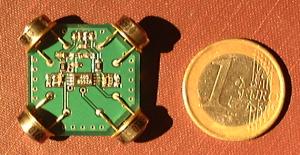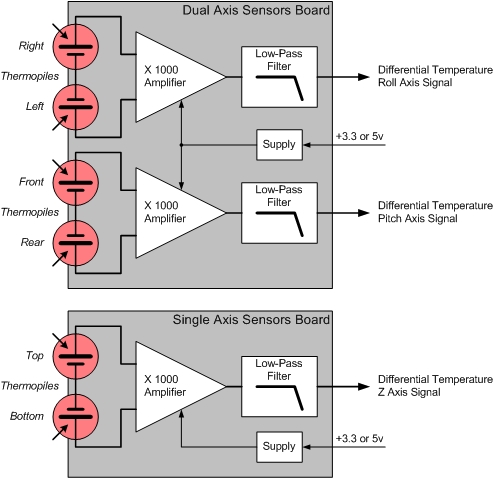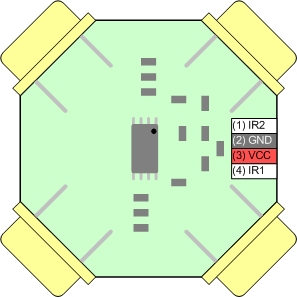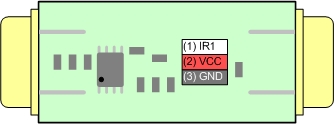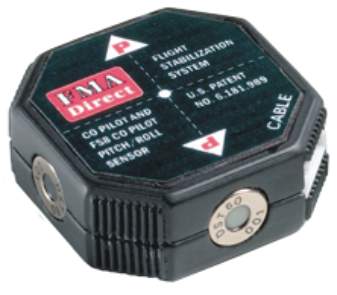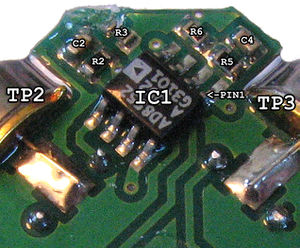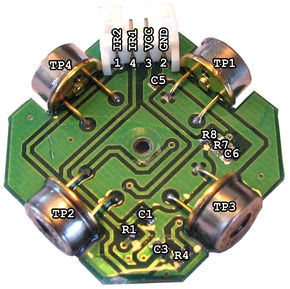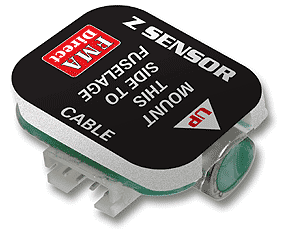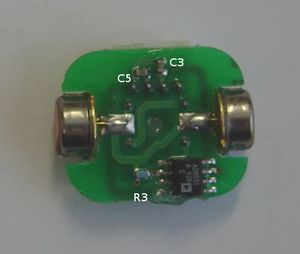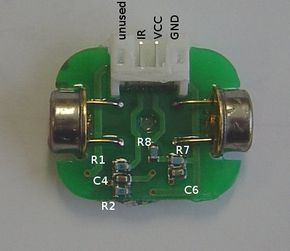Infrared Sensors
The paparazzi autopilot uses infrared thermopiles for primary attitude sensing. The theory is that at zero bank or pitch angle, the difference in the heat between the two sensors should be zero, and at 90 degrees it should be maximum. From this relationship a linear regression is made and angles are calculated during flight. Each pair of sensors measures one axis, a minimum of 2 pairs must be used to measure pitch and roll but best results are obtained thru the use of a 3rd pair on the vertical axis. Since the output signal from each sensor pair is proportional to both the attitude and the weather/terrain, systems with only x-y sensors require a ground calibration and may not provide accurate angle calculations as the aircraft travels over terrain with different IR radiation.
Architecture
Dual Axis Board Pinout
| Pin # | Name | Notes | Suggested Color |
|---|---|---|---|
| 1 | IR2 | IR Signal Output Axis 2 | Grey |
| 2 | GND | Ground | Black |
| 3 | VCC | +3.3v Power Supply | Red |
| 4 | IR1 | IR Signal Output Axis 1 | Braun |
Single Axis Board Pinout
| Pin # | Name | Notes | Suggested Color |
|---|---|---|---|
| 1 | IR | IR Signal Output | Purple |
| 2 | VCC | +3.3v Power Supply | Red |
| 3 | GND | Ground | Black |
Below is a product designed by FMA Direct and is a replacement for their Flight Stabilization system. With a simple resistor swap, this module is suitable for use in the Paparazzi UAV.
Parts
The Thermopiles are:
Manufacturer Part Number MLX90247-ESF-DSA
Digi-Key Part Number MLX90247-ESF-DSA-ND
Description IC SENS THERMOPILE W/THERM TO-39
FMA Direct CoPilot Sensor Head
Stock FMA Components
The stock FMA resistors R2/R3 and R5/R6 (0603 0.8 Mohm/0603 510 ohm) set the op amp gain to approximately 1600. Since this unit is designed to run on 5V and we are running it on 3.3V, it is advised to change R3 and R6 from 510 ohm to 1K ohm for an approximate gain of approximately 800. Without the change, it is theoretically possible to overdrive the Op Amp in extreme hot regions/seasons.
Another resistor swap option for this board is to replace R2 and R5 with 560 Kohm resistors, generating an output gain of approximately 1100; a gain which is practically identical to that of the Paparazzi board.
a suitable resistor from mouser is here
| R1 | 200 ohm |
| R2 | 0.8 Mohm |
| R3 | 510 ohm |
| R4 | 200 ohm |
| R5 | 0.8 Mohm |
| R6 | 510 ohm |
| R7 | 600 ohm |
| R8 | 600 ohm |
| C1 | 0.026 uF |
| C2 | 0.026 uF |
| C3 | 0.026 uF |
| C4 | 0.026 uF |
| C5 | 0.01 uF |
| C6 | 0.026 uF |
FMA Direct Vertical Sensor
The same operation can be done with the vertical sensor (single axis). The resistor R3 should be changed from a 510 ohm to a 1K ohm.
a suitable resistor from mouser is here
